Evaluating the Dynamics of Groundwater Storage and Its Sustainability in the Loess Plateau: The Integrated Impacts of Climate Change and Human Activities
Abstract
1. Introduction
2. Study Area and Data
2.1. Study Area
2.2. Data
2.2.1. GRACE Data
2.2.2. GLDAS Data
2.2.3. Groundwater Monitoring Data
2.2.4. Other Data
3. Research Methods
3.1. Methods for Estimating Changes in Groundwater Storage
3.2. Mutation Analysis and Trend Test
3.3. Evaluation of Groundwater Sustainability
3.4. Land Use Transition Matrix
3.5. Relative Contribution
4. Results
4.1. Reliability of Groundwater Storage Evolution
4.2. Inter-Annual Variation in Groundwater Storage in the Loess Plateau
4.3. Intra-Annual Variation in Groundwater Storage in the Loess Plateau
4.4. Spatial Variation in Groundwater Storage in the Loess Plateau
4.5. Evaluation of Groundwater Sustainability in the Loess Plateau
4.6. Drivers of Groundwater Storage Changes in the Loess Plateau
5. Discussion
5.1. Impacts of Human Activities and Climate Change on Groundwater Storage
5.2. Policy Recommendations
5.3. Future Perspectives
6. Conclusions
- (1)
- GWS in the Loess Plateau decreased at an average rate of around −6.9 ± 3.84 mm/yr between 2003 and 2022. The total GWS dropped from −4.5 mm in 2003 to −138.5 mm in 2022, amounting to a total groundwater loss of 88 km3.
- (2)
- Spatially, the eastern Loess Plateau is a hotspot for groundwater depletion, with storage declining at a rate of approximately −10.6 ± 7.54 mm/yr, which is higher than the overall average (−6.9 mm/yr), and 150% of the overall rate of decline in the Loess Plateau.
- (3)
- An assessment of groundwater sustainability using the reliability-resilience-vulnerability (RRV) framework reveals that groundwater in the Loess Plateau is at critically unsustainable levels. Although there was a slight recovery in the sustainability index between 2003 and 2006, the index has consistently deteriorated since 2006 (the Sustainability Index classification has remained extremely unsustainable). Groundwater sustainability is relatively better in the western part of the Plateau compared to the central and eastern regions.
- (4)
- Climatic factors such as precipitation, evaporation, and runoff show no significant correlation with changes in GWS in the Loess Plateau. In contrast, human activities, particularly increased water consumption and forest expansion, are the dominant drivers of GWS decline, collectively accounting for 95.8% of the reduction observed.
Author Contributions
Funding
Data Availability Statement
Acknowledgments
Conflicts of Interest
References
- Zhao, K.Y.; Fang, Z.H.; Li, J.W.; He, C.Y. Spatial-temporal variations of groundwater storage in China: A multiscale analysis based on GRACE data. Resour. Conserv. Recycl. 2023, 197, 107088. [Google Scholar] [CrossRef]
- Asoka, A.; Gleeson, T.; Wada, Y.; Mishra, V. Relative contribution of monsoon precipitation and pumping to changes in groundwater storage in India. Nat. Geosci. 2017, 10, 109–117. [Google Scholar] [CrossRef]
- Zhao, A.Z.; Xiang, K.Z.; Zhang, A.B.; Zhang, X.R. Spatial-temporal evolution of meteorological and groundwater droughts and their relationship in the North China Plain. J. Hydrol. 2022, 610, 127903. [Google Scholar] [CrossRef]
- Han, Z.M.; Huang, S.Z.; Huang, Q.; Leng, G.Y.; Wang, H.; Bai, Q.J.; Zhao, J.; Ma, L.; Wang, L.; Du, M. Propagation dynamics from meteorological to groundwater drought and their possible influence factors. J. Hydrol. 2019, 578, 124102. [Google Scholar] [CrossRef]
- Kahil, M.T.; Dinar, A.; Albiac, J. Cooperative water management and ecosystem protection under scarcity and drought in arid and semiarid regions. Water Resour. Econ. 2016, 13, 60–74. [Google Scholar] [CrossRef]
- Thomas, E.; Wilson, D.; Kathuni, S.; Libey, A.; Chintalapati, P.; Coyle, J. A contribution to drought resilience in East Africa through groundwater pump monitoring informed by in-situ instrumentation, remote sensing and ensemble machine learning. Sci. Total Environ. 2021, 780, 146486. [Google Scholar] [CrossRef]
- Famiglietti, J.S. The global groundwater crisis. Nat. Clim. Chang. 2014, 4, 945–948. [Google Scholar] [CrossRef]
- Yifru, B.A.; Lee, S.; Bak, S.; Bae, J.H.; Shin, H.; Lim, K.J. Estimating exploitable groundwater for agricultural use under environmental flow constraints using an integrated SWAT-MODFLOW model. Agric. Water Manag. 2024, 303, 109024. [Google Scholar] [CrossRef]
- Qu, W.; Zhang, P.F.; Chen, P.A.; Li, J.Y.; Gao, Y. Spatiotemporal Variations and Sustainability Characteristics of Groundwater Storage in North China from 2002 to 2022 Revealed by GRACE/GRACE Follow-On and Multiple Hydrologic Data. Remote Sens. 2024, 16, 1176. [Google Scholar] [CrossRef]
- Cao, L.; Liu, X.Q.; Zhu, P.C.; Wang, L.F. The Distribution and Evolution of Groundwater Level Depths and Groundwater Sustainability in the Hexi Corridor over the Last Five Years. Sustainability 2024, 16, 2527. [Google Scholar] [CrossRef]
- Bera, A.; Baranval, N.K.; Kumar, R.; Pal, S.K. Groundwater drought risk assessment in the semi-arid Kansai river basin, West Bengal, India using SWAT and machine learning models. Groundw. Sustain. Dev. 2024, 26, 101254. [Google Scholar] [CrossRef]
- Arshad, A.; Mirchi, A.; Samimi, M.; Ahmad, B. Combining downscaled-GRACE data with SWAT to improve the estimation of groundwater storage and depletion variations in the Irrigated Indus Basin (IIB). Sci. Total Environ. 2022, 838, 156044. [Google Scholar] [CrossRef] [PubMed]
- Jasechko, S.; Perrone, D. Global groundwater wells at risk of running dry. Science 2021, 372, 418–421. [Google Scholar] [CrossRef]
- Huang, J.; Cao, L.H.; Yu, F.R.; Liu, X.B.; Wang, L. Groundwater Drought and Cycles in Xuchang City, China. Front. Earth Sci. 2021, 9, 736305. [Google Scholar] [CrossRef]
- Jin, Z.; Guo, L.; Fan, B.H.; Lin, H.; Yu, Y.L.; Zheng, H.; Chu, G.C.; Zhang, J.; Hopkins, I. Effects of afforestation on soil and ambient air temperature in a pair of catchments on the Chinese Loess Plateau. CATENA 2019, 175, 356–366. [Google Scholar] [CrossRef]
- Thomas, B.F.; Famiglietti, J.S.; Landerer, F.W.; Wiese, D.N.; Molotch, N.P.; Argus, D.F. GRACE Groundwater Drought Index: Evaluation of California Central Valley groundwater drought. Remote Sens. Environ. 2017, 198, 384–392. [Google Scholar] [CrossRef]
- Chen, J.L.; Wilson, C.R.; Tapley, B.D.; Scanlon, B.; Güntner, A. Long-term groundwater storage change in Victoria, Australia from satellite gravity and in situ observations. Glob. Planet. Chang. 2016, 139, 56–65. [Google Scholar] [CrossRef]
- Li, B.L.; Rodell, M.; Kumar, S.; Beaudoing, H.K.; Getirana, A.; Zaitchik, B.F.; de Goncalves, L.G.; Cossetin, C.; Bhanja, S.; Mukherjee, A.; et al. Global GRACE Data Assimilation for Groundwater and Drought Monitoring: Advances and Challenges. Water Resour. Res. 2019, 55, 7564–7586. [Google Scholar] [CrossRef]
- Scanlon, B.R.; Zhang, Z.; Save, H.; Sun, A.Y.; Schmied, H.M.; van Beek, L.P.H.; Wiese, D.N.; Wada, Y.; Long, D.; Reedy, R.C.; et al. Global models underestimate large decadal declining and rising water storage trends relative to GRACE satellite data. Proc. Natl. Acad. Sci. USA 2018, 115, E1080–E1089. [Google Scholar] [CrossRef]
- Liu, M.Z.; Pei, H.W.; Shen, Y.J. Evaluating dynamics of GRACE groundwater and its drought potential in Taihang Mountain Region, China. J. Hydrol. 2022, 612, 128156. [Google Scholar] [CrossRef]
- Zhao, J.; Li, G.; Zhu, Z.Y.; Hao, Y.H.; Hao, H.Q.; Yao, J.Q.; Bao, T.; Liu, Q.; Yeh, T.C.J. Analysis of the spatiotemporal variation of groundwater storage in Ordos Basin based on GRACE gravity satellite data. J. Hydrol. 2024, 632, 130931. [Google Scholar] [CrossRef]
- Amiri, V.; Ali, S.; Sohrabi, N. Estimating the spatio-temporal assessment of GRACE/GRACE-FO derived groundwater storage depletion and validation with in-situ water quality data (Yazd province, central Iran). J. Hydrol. 2023, 620, 129416. [Google Scholar] [CrossRef]
- Pokhrel, Y.; Felfelani, F.; Satoh, Y.; Boulange, J.; Burek, P.; Gädeke, A.; Gerten, D.; Gosling, S.N.; Grillakis, M.; Gudmundsson, L.; et al. Global terrestrial water storage and drought severity under climate change. Nat. Clim. Chang. 2021, 11, 226–233. [Google Scholar] [CrossRef]
- Wada, Y.; Bierkens, M.F.; De Roo, A.; Dirmeyer, P.A.; Famiglietti, J.S.; Hanasaki, N.; Konar, M.; Liu, J.; Schmied, H.M.; Oki, T.J.H.; et al. Human–water interface in hydrological modelling: Current status and future directions. Hydrol. Earth Syst. Sci. 2017, 21, 4169–4193. [Google Scholar] [CrossRef]
- Rodell, M.; Velicogna, I.; Famiglietti, J.S. Satellite-based estimates of groundwater depletion in India. Nature 2009, 460, 999–1002. [Google Scholar] [CrossRef]
- Xu, N.; Lu, H.; Li, W.; Gong, P. Natural lakes dominate global water storage variability. Sci. Bull. 2024, 69, 1016–1019. [Google Scholar] [CrossRef]
- Zhang, C.; Chen, P.; Zhu, C.C.; Lu, J.R.; Zhang, Y.C.; Yang, X.Y.; Wu, M.Y. Assessment of natural and anthropogenic impacts on terrestrial water storage in the Loess Plateau based on different types of GRACE/GRACE-FO solutions. J. Mt. Sci. 2024, 21, 2173–2192. [Google Scholar] [CrossRef]
- Cai, Y.; Zhang, F.; Duan, P.; Jim, C.Y.; Chan, N.W.; Shi, J.; Liu, C.; Wang, J.; Bahtebay, J.; Ma, X. Vegetation cover changes in China induced by ecological restoration-protection projects and land-use changes from 2000 to 2020. CATENA 2022, 217, 106530. [Google Scholar] [CrossRef]
- Wen, X.; Zhen, L. Soil erosion control practices in the Chinese Loess Plateau: A systematic review. Environ. Dev. 2020, 34, 100493. [Google Scholar] [CrossRef]
- Cao, S.; Zhang, J.; Chen, L.; Zhao, T. Ecosystem water imbalances created during ecological restoration by afforestation in China, and lessons for other developing countries. J. Environ. Manag. 2016, 183, 843–849. [Google Scholar] [CrossRef]
- Ramjeawon, M.; Demlie, M.; Toucher, M. Analyses of groundwater storage change using GRACE satellite data in the Usutu-Mhlatuze drainage region, north-eastern South Africa. J. Hydrol.-Reg. Stud. 2022, 42, 101118. [Google Scholar] [CrossRef]
- Wei, L.Y.; Jiang, S.H.; Ren, L.L.; Tan, H.B.; Ta, W.Q.; Liu, Y.; Yang, X.L.; Zhang, L.Q.; Duan, Z. Spatiotemporal changes of terrestrial water storage and possible causes in the closed Qaidam Basin, China using GRACE and GRACE Follow-On data. J. Hydrol. 2021, 598, 126274. [Google Scholar] [CrossRef]
- Zhong, Y.L.; Zhong, M.; Feng, W.; Zhang, Z.Z.; Shen, Y.C.; Wu, D.C. Groundwater depletion in the West Liaohe River Basin, China and its implications revealed by GRACE and in situ measurements. Remote Sens. 2018, 10, 493. [Google Scholar] [CrossRef]
- Mo, X.; Wu, J.J.; Wang, Q.; Zhou, H. Variations in water storage in China over recent decades from GRACE observations and GLDAS. Nat. Hazards Earth Syst. Sci. 2016, 16, 469–482. [Google Scholar] [CrossRef]
- Yan, X.; Sun, J.E.; Huang, Y.A.; Xia, Y.; Wang, Z.S.; Li, Z. Detecting and attributing the changes in baseflow in China’s Loess Plateau. J. Hydrol. 2023, 617, 128957. [Google Scholar] [CrossRef]
- Li, P.; Chen, J.; Zhao, G.; Holden, J.; Liu, B.; Chan, F.K.S.; Hu, J.; Wu, P.; Mu, X. Determining the drivers and rates of soil erosion on the Loess Plateau since 1901. Sci. Total Environ. 2022, 823, 153674. [Google Scholar] [CrossRef]
- Yu, Y.; Zhao, W.; Martinez-Murillo, J.F.; Pereira, P. Loess Plateau: From degradation to restoration. Sci. Total Environ. 2020, 738, 140206. [Google Scholar] [CrossRef]
- Han, Z.M.; Huang, Q.; Huang, S.Z.; Leng, G.Y.; Bai, Q.J.; Liang, H.; Wang, L.; Zhao, J.; Fang, W. Spatial-temporal dynamics of agricultural drought in the Loess Plateau under a changing environment: Characteristics and potential influencing factors. Agric. Water Manag. 2021, 244, 106540. [Google Scholar] [CrossRef]
- Abbott, B.W.; Bishop, K.; Zarnetske, J.P.; Minaudo, C.; Chapin, F.S.; Krause, S.; Hannah, D.M.; Conner, L.; Ellison, D.; Godsey, S.E.; et al. Human domination of the global water cycle absent from depictions and perceptions. Nat. Geosci. 2019, 12, 533–540. [Google Scholar] [CrossRef]
- Yin, J.; He, F.; Xiong, Y.J.; Qiu, G.Y. Effects of land use/land cover and climate changes on surface runoff in a semi-humid and semi-arid transition zone in northwest China. Hydrol. Earth Syst. Sci. 2017, 21, 183–196. [Google Scholar] [CrossRef]
- Wang, F.; Wang, Z.; Yang, H.; Di, D.; Zhao, Y.; Liang, Q.J.J.o.H. Utilizing GRACE-based groundwater drought index for drought characterization and teleconnection factors analysis in the North China Plain. J. Hydrol. 2020, 585, 124849. [Google Scholar] [CrossRef]
- Yi, S.; Sneeuw, N. Filling the Data Gaps Within GRACE Missions Using Singular Spectrum Analysis. J. Geophys. Res.-Solid Earth 2021, 126, e2020JB021227. [Google Scholar] [CrossRef]
- Xie, J.; Xu, Y.-P.; Wang, Y.; Gu, H.; Wang, F.; Pan, S. Influences of climatic variability and human activities on terrestrial water storage variations across the Yellow River basin in the recent decade. J. Hydrol. 2019, 579, 124218. [Google Scholar] [CrossRef]
- Yang, J.; Huang, X. The 30 m annual land cover dataset and its dynamics in China from 1990 to 2019. Earth Syst. Sci. Data 2021, 13, 3907–3925. [Google Scholar] [CrossRef]
- Praveen, B.; Talukdar, S.; Shahfahad; Mahato, S.; Mondal, J.; Sharma, P.; Islam, A.M.T.; Rahman, A. Analyzing trend and forecasting of rainfall changes in India using non-parametrical and machine learning approaches. Sci. Rep. 2020, 10, 10342. [Google Scholar] [CrossRef]
- Ahmad, I.; Zhang, F.; Tayyab, M.; Anjum, M.N.; Zaman, M.; Liu, J.G.; Farid, H.U.; Saddique, Q. Spatiotemporal analysis of precipitation variability in annual, seasonal and extreme values over upper Indus River basin. Atmos. Res. 2018, 213, 346–360. [Google Scholar] [CrossRef]
- Loucks, D.P. Quantifying trends in system sustainability. Hydrol. Sci. J. 1997, 42, 513–530. [Google Scholar] [CrossRef]
- Feng, W.; Zhong, M.; Lemoine, J.M.; Biancale, R.; Hsu, H.T.; Xia, J. Evaluation of groundwater depletion in North China using the Gravity Recovery and Climate Experiment (GRACE) data and ground-based measurements. Water Resour. Res. 2013, 49, 2110–2118. [Google Scholar] [CrossRef]
- Ashraf, S.; Ali, M.; Shrestha, S.; Hafeez, M.A.; Moiz, A.; Sheikh, Z.A. Impacts of climate and land-use change on groundwater recharge in the semi-arid lower Ravi River basin, Pakistan. Groundw. Sustain. Dev. 2022, 17, 100743. [Google Scholar] [CrossRef]
- Yin, Z.; Xu, Y.; Zhu, X.; Zhao, J.; Yang, Y.; Li, J. Variations of groundwater storage in different basins of China over recent decades. J. Hydrol. 2021, 598, 126282. [Google Scholar] [CrossRef]
- Riedel, T.; Weber, T.K. The influence of global change on Europe’s water cycle and groundwater recharge. Hydrogeol. J. 2020, 28, 1939–1959. [Google Scholar] [CrossRef]
- Chen, X.; Jiang, J.; Lei, T.; Yue, C. GRACE satellite monitoring and driving factors analysis of groundwater storage under high-intensity coal mining conditions: A case study of Ordos, northern Shaanxi and Shanxi, China. Hydrogeol. J. 2020, 28, 673–686. [Google Scholar] [CrossRef]
- Adhikari, R.K.; Mohanasundaram, S.; Shrestha, S. Impacts of land-use changes on the groundwater recharge in the Ho Chi Minh city, Vietnam. Environ. Res. 2020, 185, 109440. [Google Scholar] [CrossRef] [PubMed]
- Huang, T.M.; Pang, Z.H. Estimating groundwater recharge following land-use change using chloride mass balance of soil profiles: A case study at Guyuan and Xifeng in the Loess Plateau of China. Hydrogeol. J. 2011, 19, 177–186. [Google Scholar] [CrossRef]
- Chen, P.Y.; Ma, X.Y.; Ma, J.Z.; Zeng, H.T.; Huang, Q.M.; Wang, Y.Y.; Zhou, Y.; Zhang, L. Discrepancy and estimates of groundwater recharge under different land use types on the Loess Plateau. J. Hydrol. Reg. Stud 2024, 53, 101793. [Google Scholar] [CrossRef]
- Zhang, Z.D.; Huang, M.B.; Zhao, X.F.; Wu, L.H. Adjustments of leaf traits and whole plant leaf area for balancing water supply and demand in Robinia pseudoacacia under different precipitation conditions on the Loess Plateau. Agric. For. Meteorol. 2019, 279, 107733. [Google Scholar] [CrossRef]
- Jia, X.X.; Wang, Y.Q.; Shao, M.A.; Luo, Y.; Zhang, C.C. Estimating regional losses of soil water due to the conversion of agricultural land to forest in China’s Loess Plateau. Ecohydrology 2017, 10, e1851. [Google Scholar] [CrossRef]
- Zhang, Q.; Lv, X.; Yu, X.; Ni, Y.; Ma, L.; Liu, Z. Species and spatial differences in vegetation rainfall interception capacity: A synthesis and meta-analysis in China. CATENA 2022, 213, 106223. [Google Scholar] [CrossRef]
- Zhong, L.H.; Hua, L.J.; Yao, Y.; Feng, J.M. Interdecadal aridity variations in Central Asia during 1950-2016 regulated by oceanic conditions under the background of global warming. Clim. Dyn. 2021, 56, 3665–3686. [Google Scholar] [CrossRef]
- Zhang, Q.; Yang, J.H.; Wang, W.; Ma, P.L.; Lu, G.Y.; Liu, X.Y.; Yu, H.P.; Fang, F. Climatic Warming and Humidification in the Arid Region of Northwest China: Multi-Scale Characteristics and Impacts on Ecological Vegetation. J. Meteorolog. Res. 2021, 35, 113–127. [Google Scholar] [CrossRef]
- Wang, Q.; Zhai, P.-M.; Qin, D.-H. New perspectives on ‘warming–wetting’ trend in Xinjiang, China. Adv. Clim. Chang. Res. 2020, 11, 252–260. [Google Scholar] [CrossRef]
- Li, M.X.; Ma, Z.G. Decadal changes in summer precipitation over arid northwest China and associated atmospheric circulations. Int. J. Climatol. 2018, 38, 4496–4508. [Google Scholar] [CrossRef]
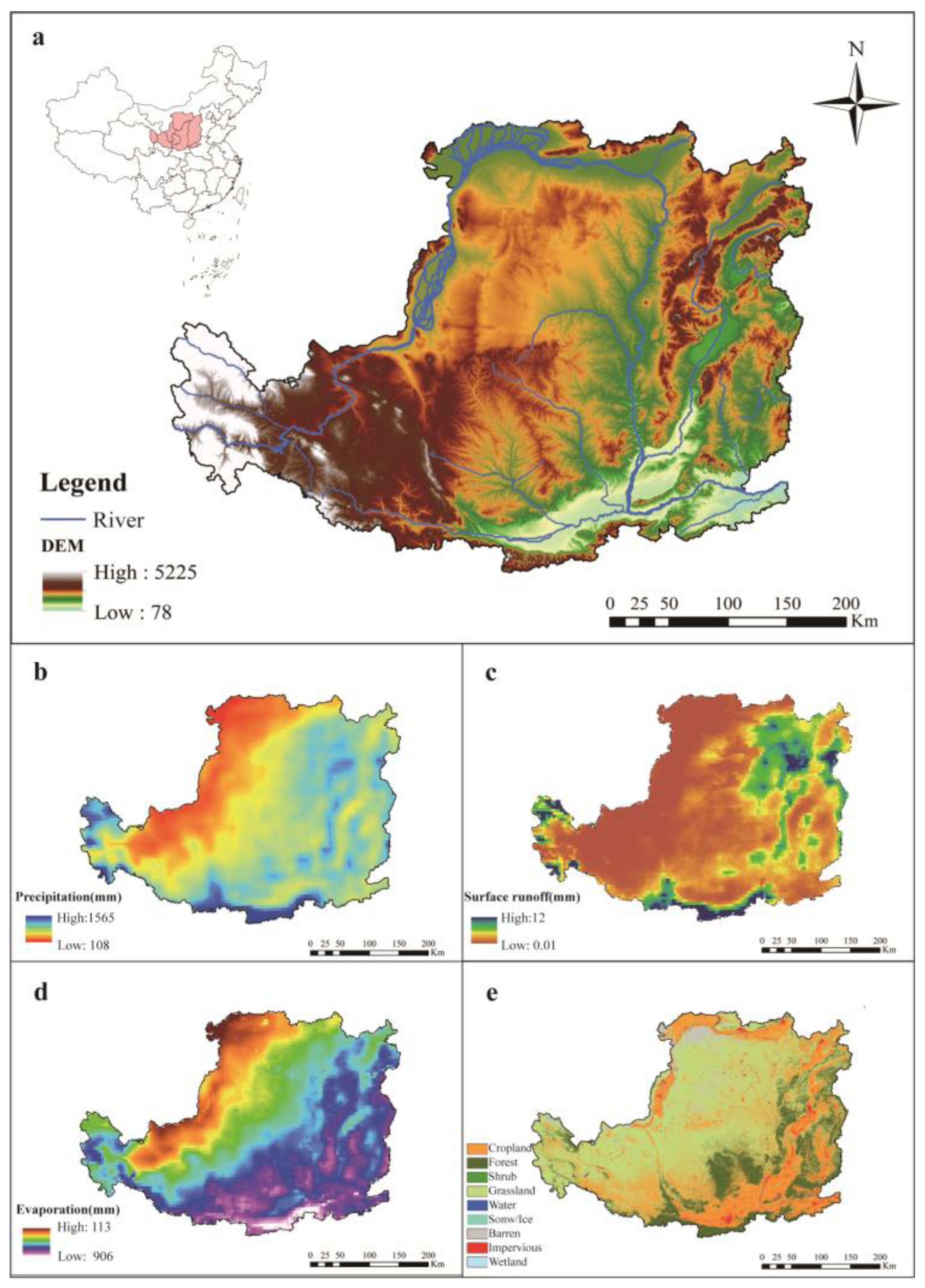
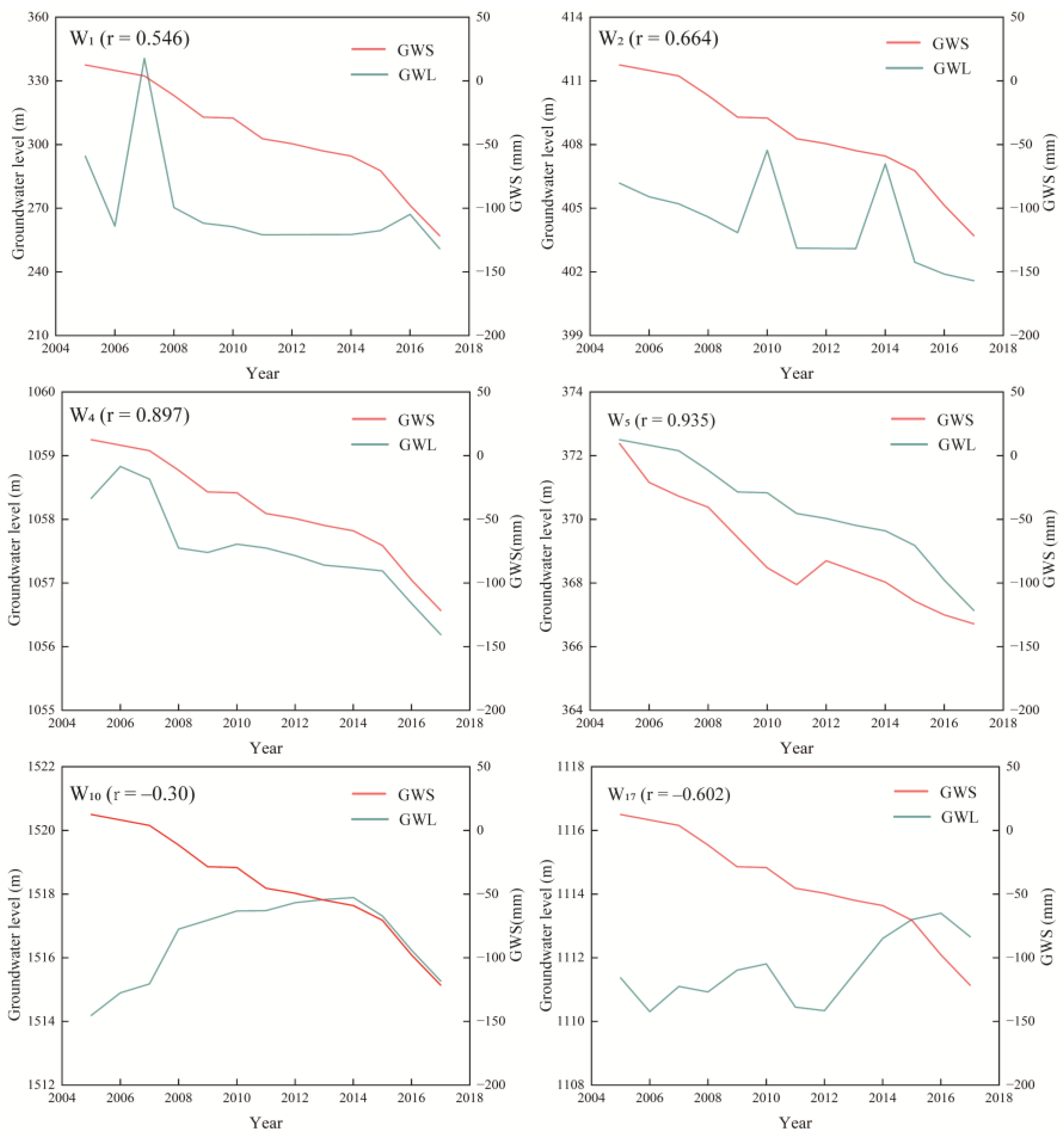
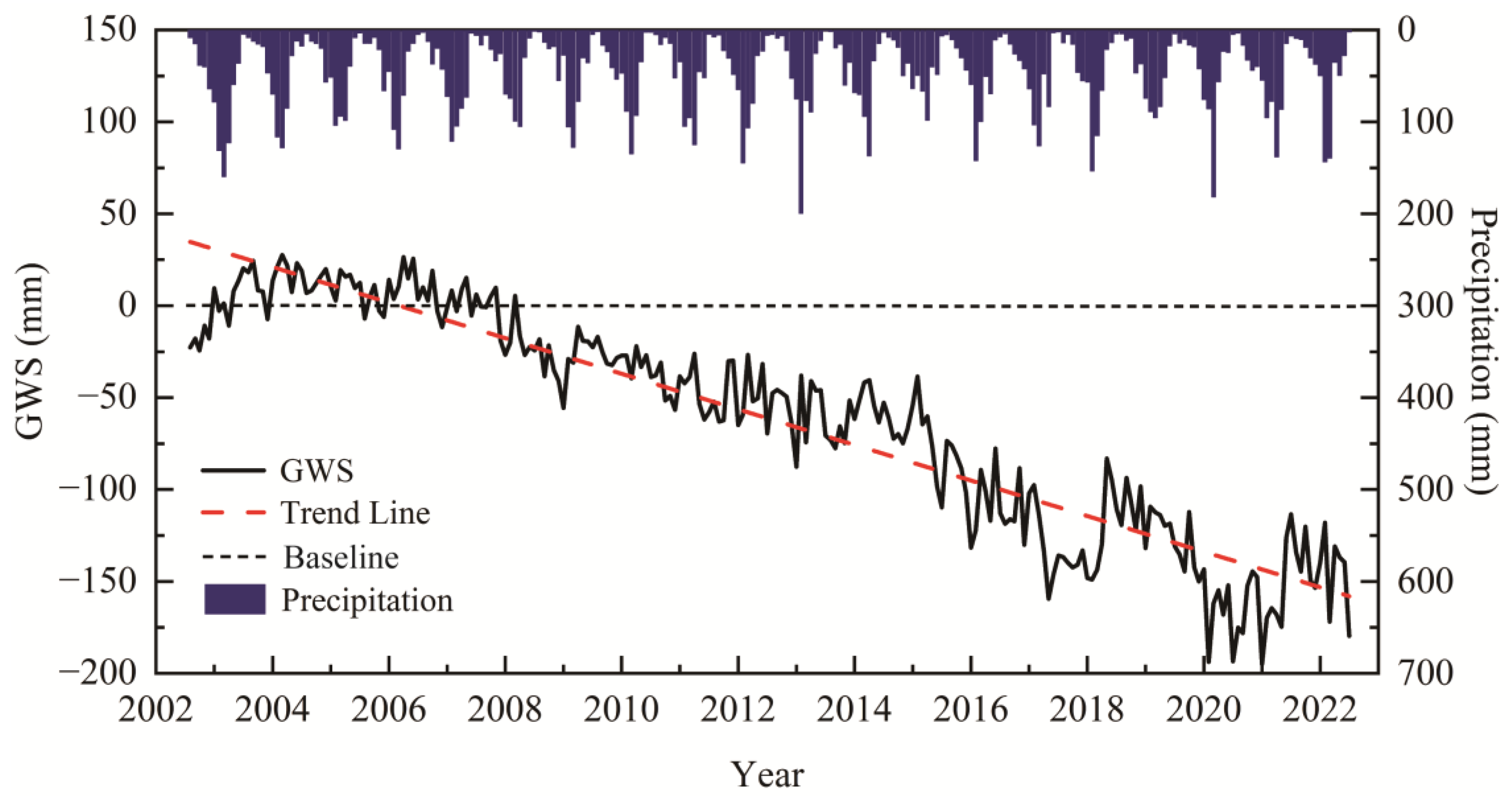

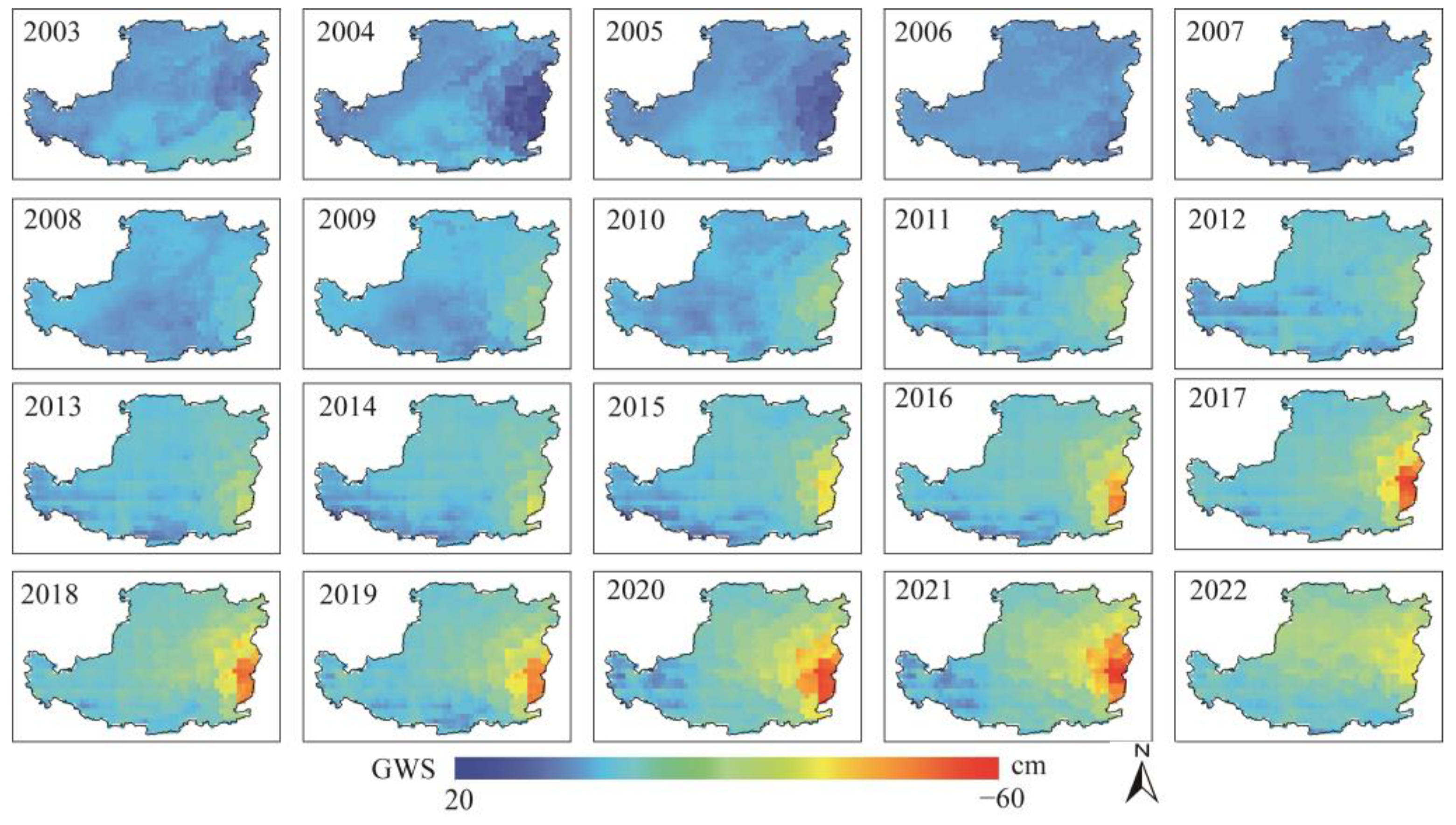
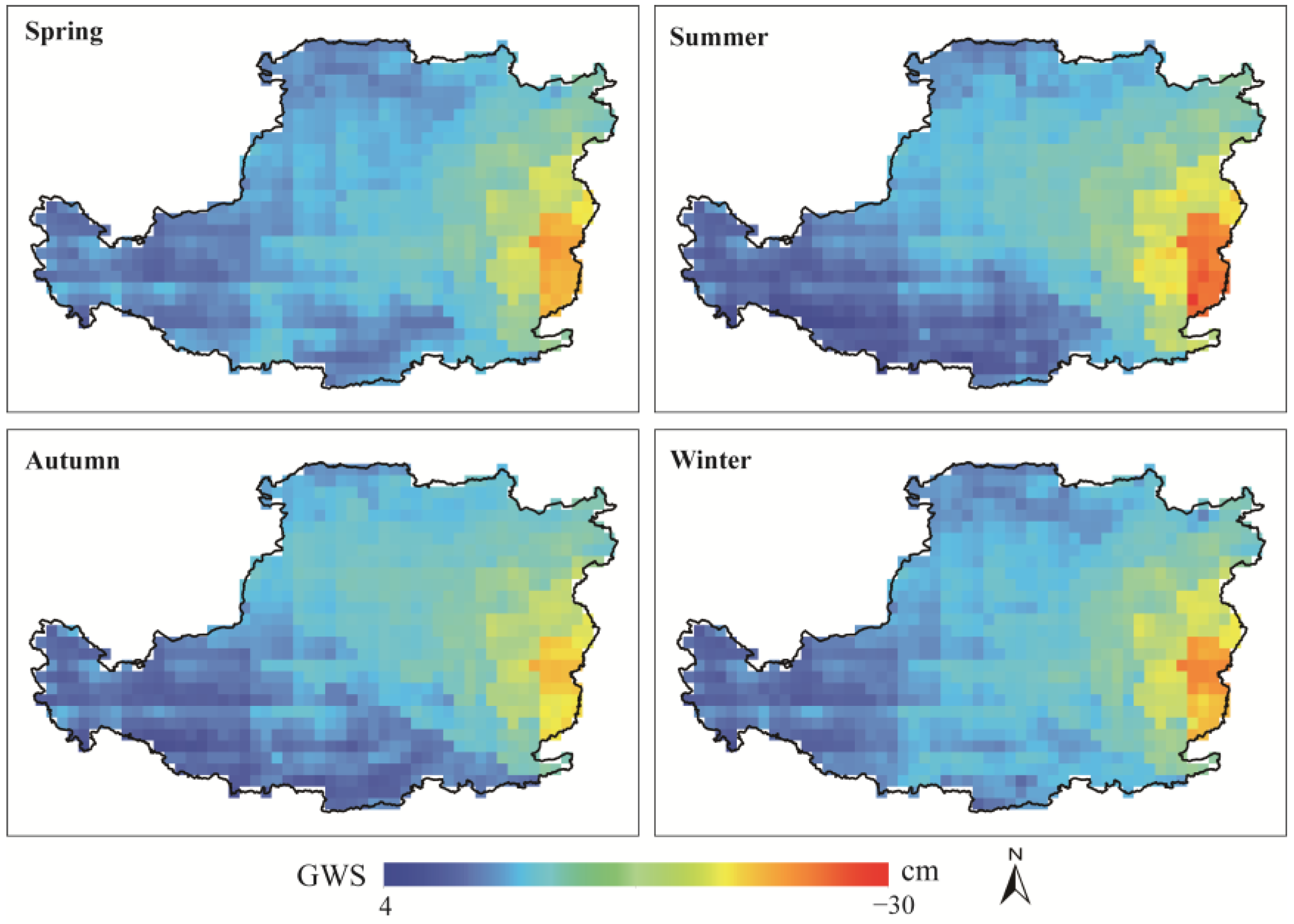
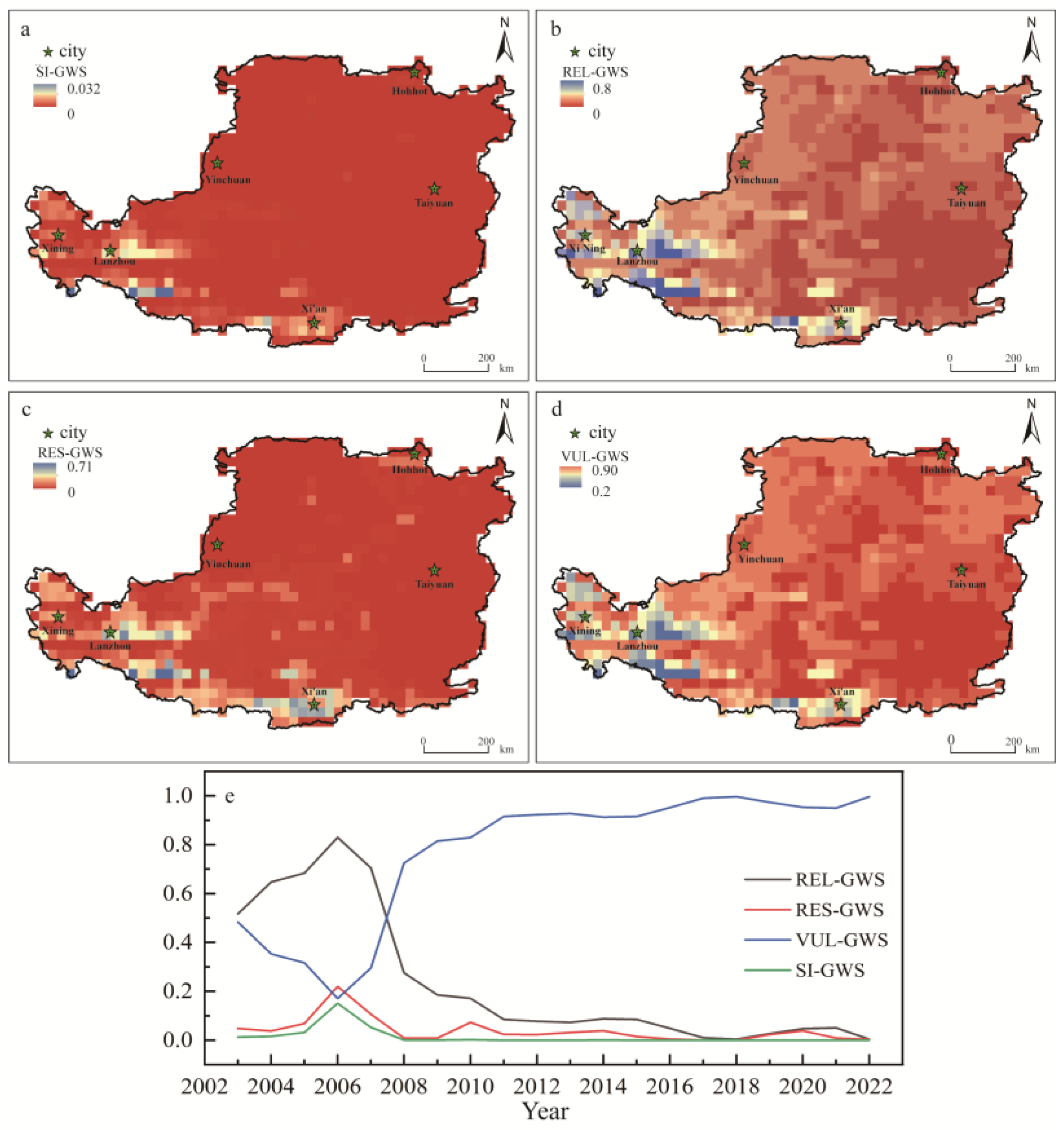
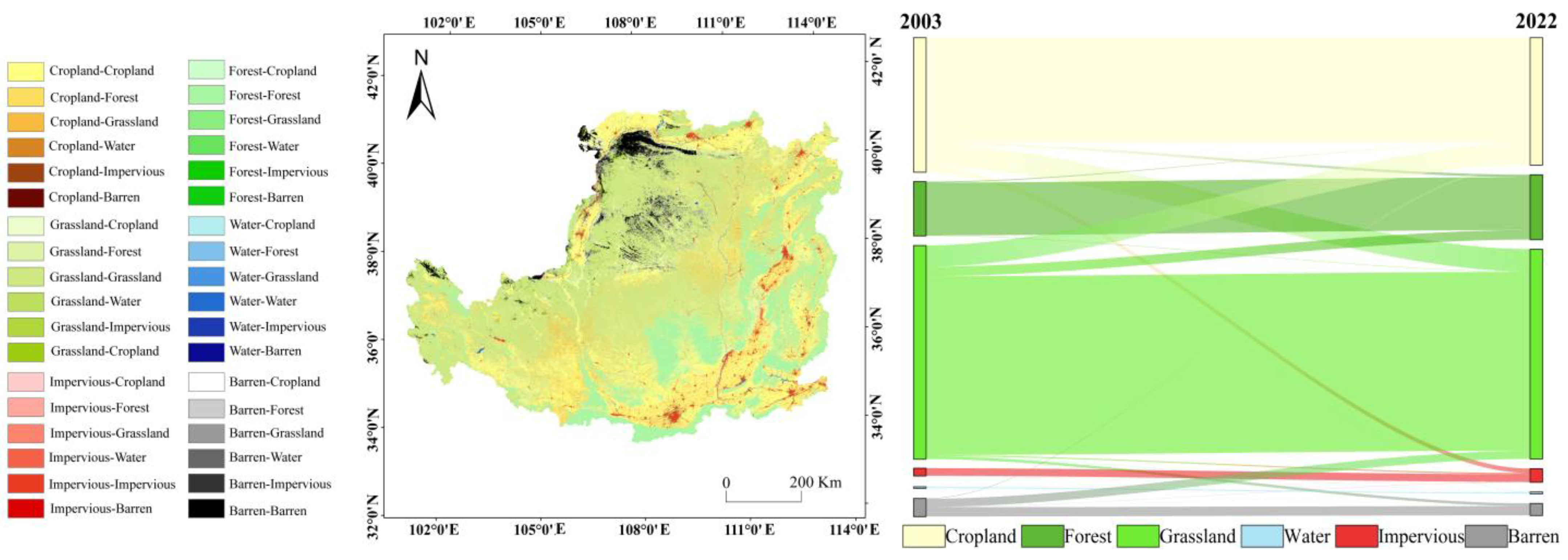

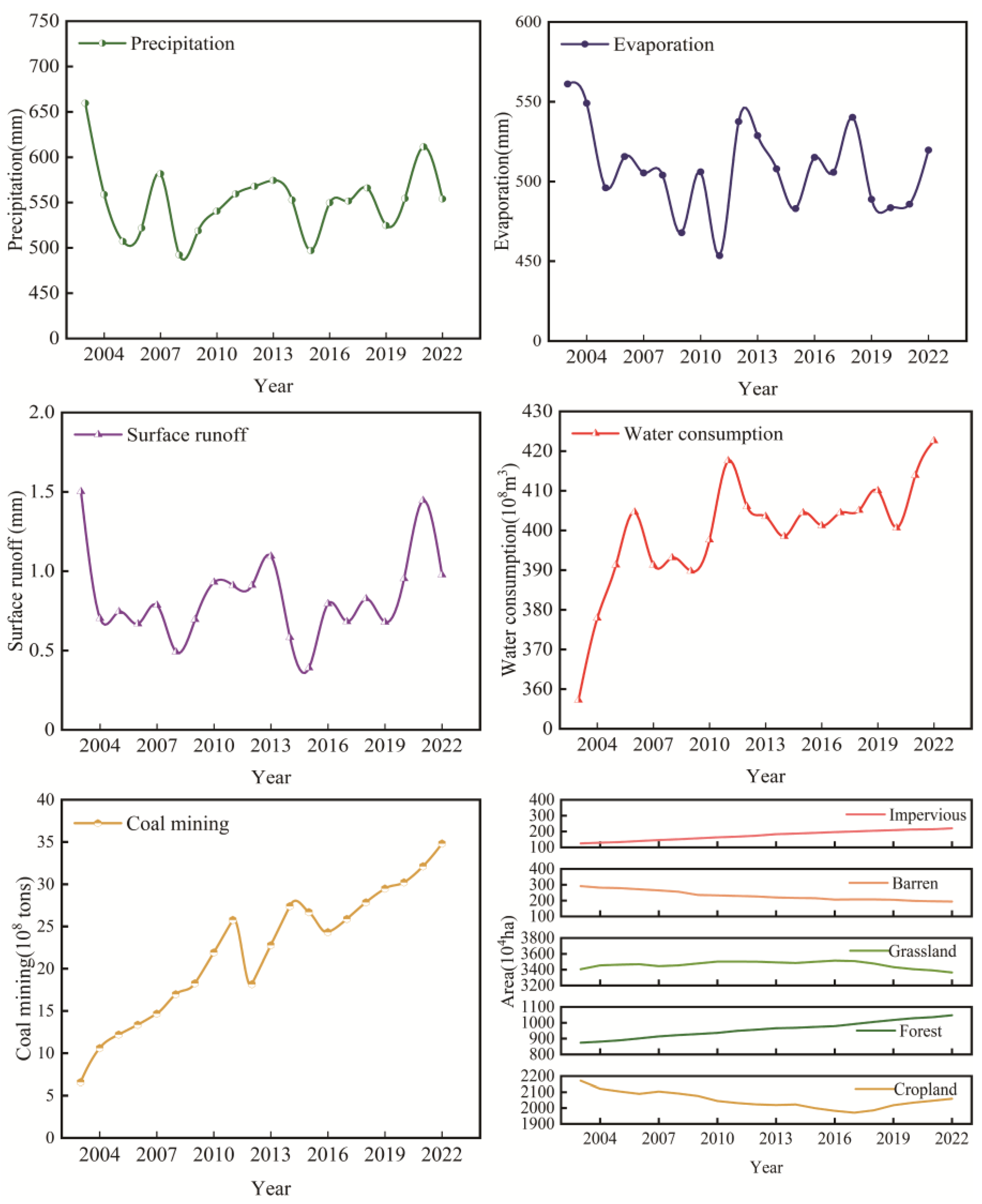
| Wells | Location | Elevation (m) | Monitoring Depth (m) | Type | Correlation (r) |
|---|---|---|---|---|---|
| W1 | Yuncheng | 346.73 | 92.20–194.00 | confined aquifer | 0.546 |
| W2 | Linfen | 447.82 | 57.28–187.00 | confined aquifer | 0.664 |
| W3 | Changzhi | 934.61 | 0.00–160.00 | confined aquifer | 0.789 |
| W4 | Shuozhou | 1096.4 | 0.00–439.94 | confined aquifer | 0.897 |
| W5 | Xian | 383.15 | 15.00–40.00 | unconfined aquifer | 0.935 |
| W6 | Xian | 409.26 | 12.00–16.00 | unconfined aquifer | −0.175 |
| W7 | Xianyang | 392.82 | 26.00–32.00 | confined aquifer | 0.128 |
| W8 | Xianyang | 559.00 | 10.00–28.00 | unconfined aquifer | 0.737 |
| W9 | Weinan | 338.77 | 30.00–45.00 | unconfined aquifer | 0.537 |
| W10 | Lanzhou | 1523.39 | 7.03–94.80 | unconfined aquifer | −0.30 |
| W11 | Lanzhou | 1529.26 | 9.21–100.80 | unconfined aquifer | 0.587 |
| W12 | Tianshui | 1209.67 | 3.28–7.00 | unconfined aquifer | 0.93 |
| W13 | Dingxi | 1665.58 | 24.06–45.00 | unconfined aquifer | 0.578 |
| W14 | Qingyang | 1399.43 | 0.00–46.54 | unconfined aquifer | 0.949 |
| W15 | Qingyang | 1381.15 | 0.00–47.00 | unconfined aquifer | −0.869 |
| W16 | Yinchuan | 1109.54 | 0.00–90.00 | confined aquifer | 0.863 |
| W17 | Yinchuan | 1120.52 | 0.00–45.00 | confined aquifer | −0.602 |
| W18 | Baotou | 1025.52 | 154.04–180.59 | confined aquifer | −0.632 |
| W19 | Baotou | 1062.66 | 10.00–40.05 | unconfined aquifer | 0.117 |
| W20 | Xining | 2506.94 | 12.58–53.00 | unconfined aquifer | 0.875 |
| W21 | Xining | 2480.49 | 1.82–27.30 | unconfined aquifer | 0.891 |
Disclaimer/Publisher’s Note: The statements, opinions and data contained in all publications are solely those of the individual author(s) and contributor(s) and not of MDPI and/or the editor(s). MDPI and/or the editor(s) disclaim responsibility for any injury to people or property resulting from any ideas, methods, instructions or products referred to in the content. |
© 2024 by the authors. Licensee MDPI, Basel, Switzerland. This article is an open access article distributed under the terms and conditions of the Creative Commons Attribution (CC BY) license (https://creativecommons.org/licenses/by/4.0/).
Share and Cite
Li, J.; Ma, J. Evaluating the Dynamics of Groundwater Storage and Its Sustainability in the Loess Plateau: The Integrated Impacts of Climate Change and Human Activities. Remote Sens. 2024, 16, 4375. https://doi.org/10.3390/rs16234375
Li J, Ma J. Evaluating the Dynamics of Groundwater Storage and Its Sustainability in the Loess Plateau: The Integrated Impacts of Climate Change and Human Activities. Remote Sensing. 2024; 16(23):4375. https://doi.org/10.3390/rs16234375
Chicago/Turabian StyleLi, Jifei, and Jinzhu Ma. 2024. "Evaluating the Dynamics of Groundwater Storage and Its Sustainability in the Loess Plateau: The Integrated Impacts of Climate Change and Human Activities" Remote Sensing 16, no. 23: 4375. https://doi.org/10.3390/rs16234375
APA StyleLi, J., & Ma, J. (2024). Evaluating the Dynamics of Groundwater Storage and Its Sustainability in the Loess Plateau: The Integrated Impacts of Climate Change and Human Activities. Remote Sensing, 16(23), 4375. https://doi.org/10.3390/rs16234375






